Description of dousing devices for a bath and their installation
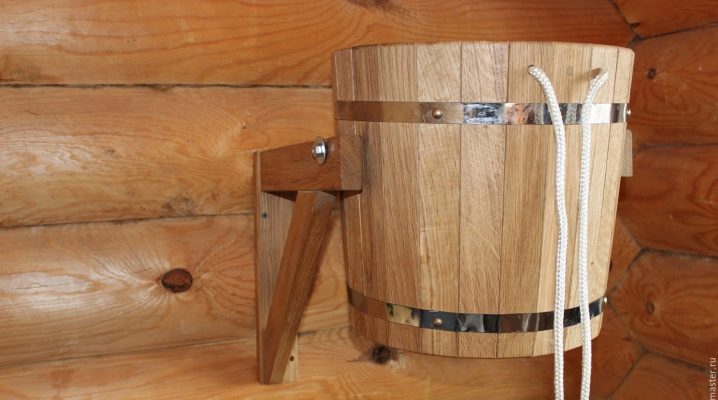
The bathhouse is a unique place where you can not only take water procedures, but also relax with a company. Visiting it is a ritual that includes a number of points. Warming up in the sauna, cooling in the snow or in the lake, rest. But if there are no bodies of water, rivers or lakes near the house, you can build a pool. Unfortunately, not everyone has this opportunity. Therefore, the ideal option in this case (which will take up little space) is a douche device.
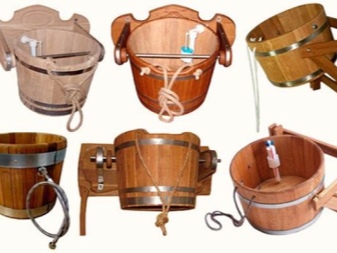
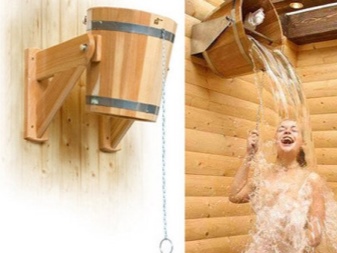
What it is?
Many people know that dousing with cold water is hardening. It is especially good to do this after being in the bath. This effect is often compared to a contrast shower.
Previously, when the baths did not have running water, water was dragged in buckets for the water heating tank. Therefore, there was no need for special pouring equipment. He took a bucket and went out into the street.
Gradually, when it became possible to carry out a water supply system, many people had a question of how to pour over now. The answer is simple - a pouring device. But what is it?
The pouring device consists of three main parts, namely:
-
bucket;
-
fastening elements;
-
a float that controls the liquid level.
This also includes the ropes, due to which the bucket is turned over.
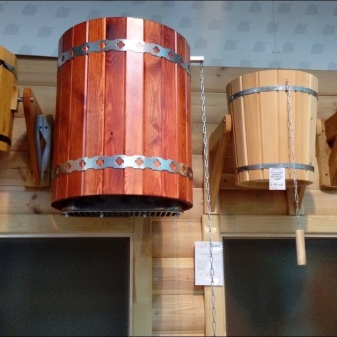

Such a device is installed in a bath, washing room, sauna, in a bathroom, or in a specially designated place (above the font). And also some install this structure on the street, in a place convenient for themselves.
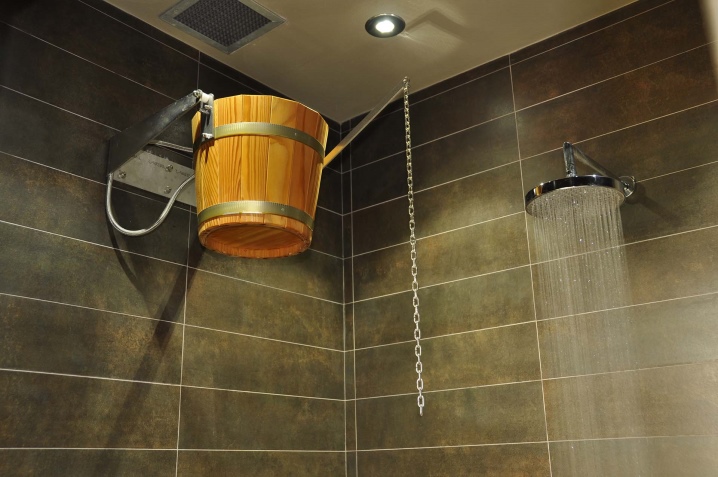
The device has a number of advantages that you should pay attention to.
-
Availability. You can find a douche bucket in any specialty store. One has only to ask a consultant and select the required size and additional elements.
-
Long service life. This unit does not have a limited time of use, which inclines towards purchasing it.
-
Environmental materials. Buckets are mostly made of wood (you can also choose wood to your taste).
-
Ease of assembly and installation. Such a structure can be independently assembled and attached.
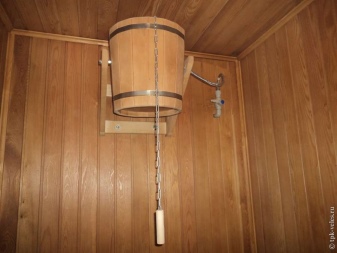

How it works? The bucket is filled with water. This is done on purpose in advance so that the wood swells and the liquid does not pour through the cracks. The required volume is being recruited. If water is supplied to the system, then a special float will control the water level, which will turn off the water supply when it reaches a predetermined level. If you pull on the rope, the bucket will tip over and the float will start working again, filling the container.
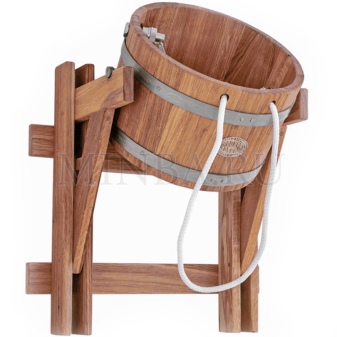
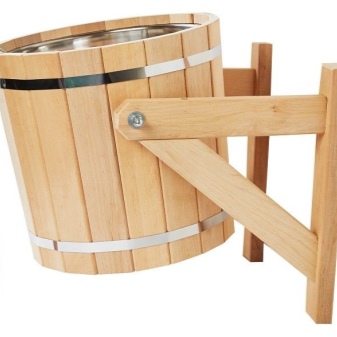
What are they?
The designs of the pouring devices themselves do not differ in any way. The main differences are only in the material, and the principle of operation is the same. But it is still worth considering what they are.
Basically, buckets differ from each other. The average volume chosen for one person is 20 liters.
A volume of 30 or 40 liters is quite large, and it is usually chosen by people who have been hardening for a long time, and their body is resistant to such a large amount of cold water.
For people who have just started using this system, it is still worth turning their attention to 10-liter buckets. This will allow you to get used to the procedure and will not shock the body.
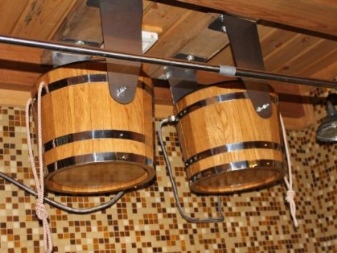
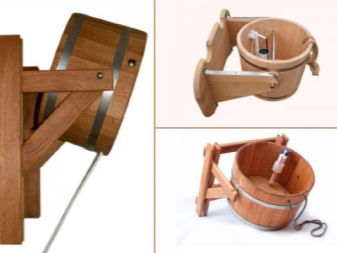
Solid oak, cedar or larch is usually chosen as the material of manufacture.This wood does not lend itself to rotting under the influence of water, which means it will last a long time.
Modern systems "Waterfall" have the ability to directly replenish water without human intervention. To do this, it is necessary to connect the water supply to the system, and the float will be responsible for adjusting the filling.
But still, over time, wood tends to dry out, so there are special plastic liners. They are either purchased separately for the required diameter, or are built into the bucket itself.
By the same principle, there are also models with a stainless insert in order to extend the service life. And it is also quite convenient, since if the system is located directly in the bath itself, then such inserts will not allow the container to heat up.
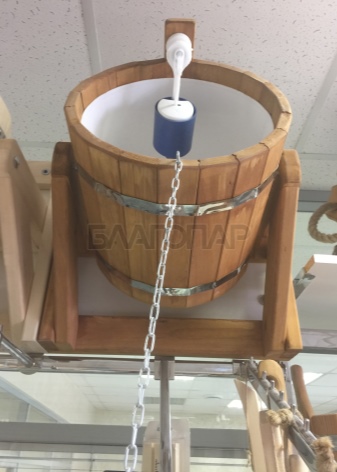

Popular models
Several options are considered popular models among pouring devices.
-
"Waterfall". He takes one of the first places, because his principle of operation is the simplest. By pulling the rope down, the bucket tilts over, and the water pours out in a waterfall continuously. For this ability, the system received such a name.
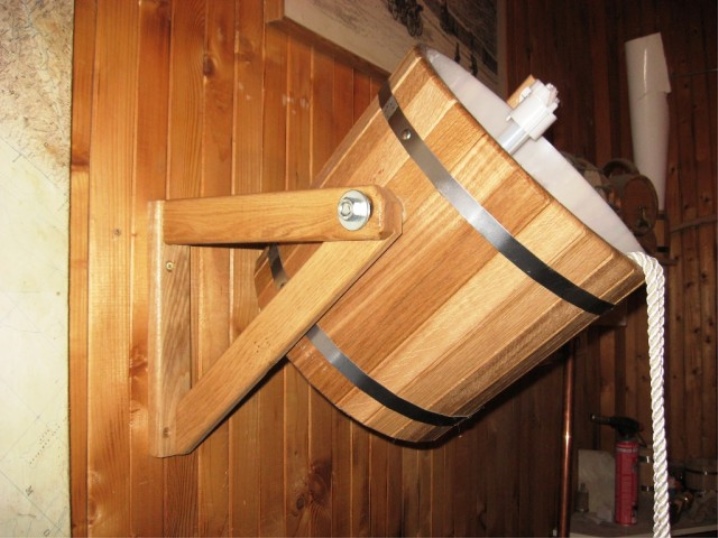
- The second popular option is Tumbler. Quite an interesting model. Its principle of operation lies in the fact that it is necessary to pull the rope down, as if starting the mechanism, and the container overturns and sways, pouring out the liquid.
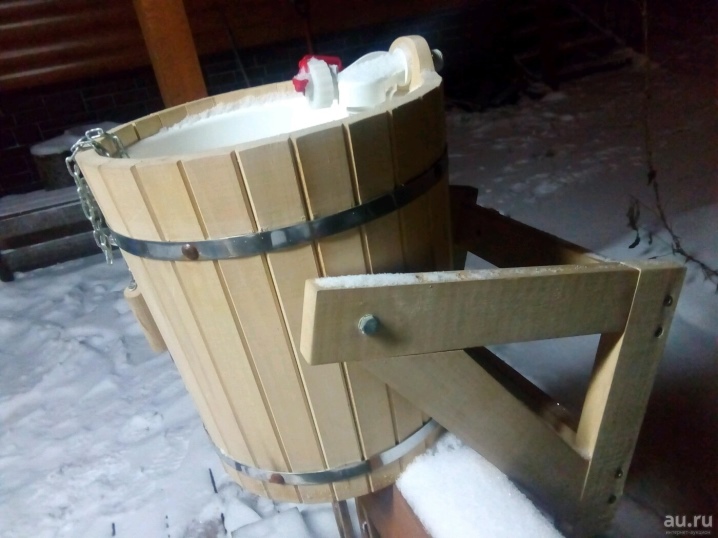
- Easysteam "Cascade" is a modern model of the pouring system. It is completely stainless steel, often square in shape. Its principle of action is similar to that of a shower. In this model, the chain is the trigger. If you pull on it, the water will pour out in jets, like through a watering can. With a principle similar to this, there is the "Rain" mechanism.
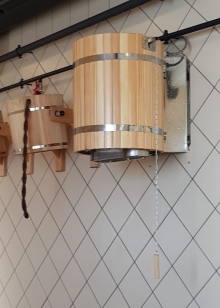
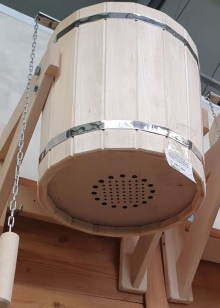

-
"Kolobok", like the above presented model, is a modern version of pouring devices. It is made entirely of stainless steel, shaped like a cylinder, and has a small drain hole on the top side.
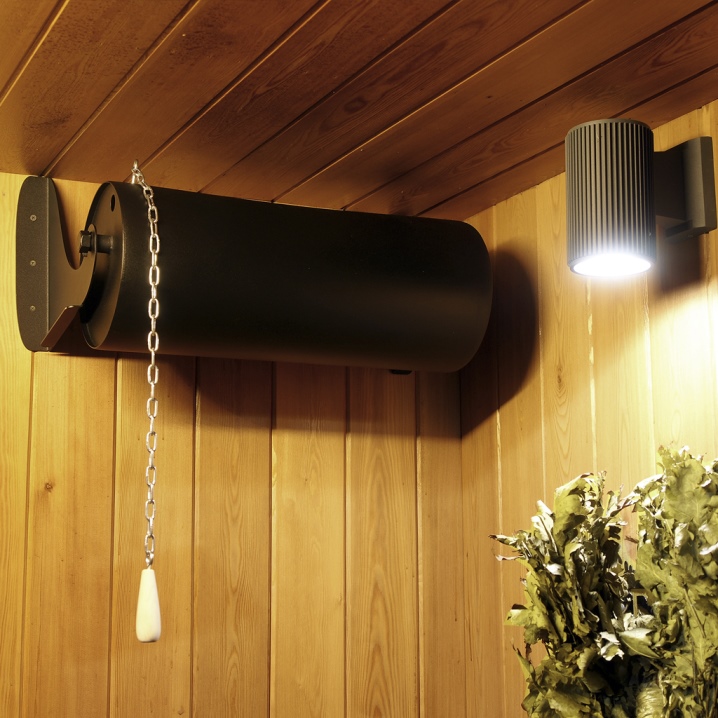
Selection Tips
After a hot steam room, it is always nice to douse yourself with cold water to "throw off" all the heat. This is not only pleasant, but also very useful. Therefore, if possible, it is worth purchasing such a system.
But what should you pay attention to? After a long study of the varieties of pouring devices, it is worth thinking about exactly what volume you need to purchase. On average, this is 20 liters per person. But there are models with a large number of liters.
Pay your attention to the fact that if you choose only wood as a material, then you will need to take additional care of it. It is not worth keeping water in a barrel constantly, as it has the properties of stagnation and freezing. Therefore, the water should always be drained. Drying can be avoided by choosing a coated bucket (plastic or steel). This, of course, is not necessary, but the service life will significantly increase.
The main thing is the size, namely the height. Due to the low height, sometimes this or that model may not fit and spoil the shower process.
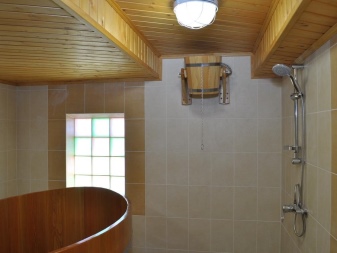
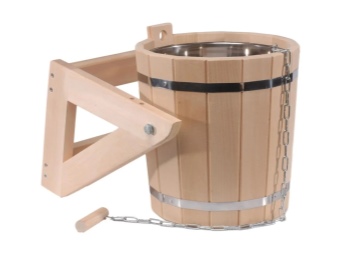
Therefore, before purchasing this or that system, you need to make sure that the dimensions really allow for installation.
Installation steps
Self-assembly does not require special knowledge, but nevertheless, certain skills will be required. You need to know how to supply water, how to properly attach the frame, what height to choose, and most importantly, how to choose the right place.
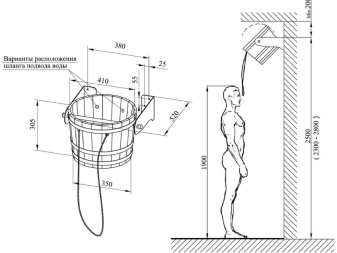

Seat selection
When installing, the first thing to do is choose a location. If the bath is large, and it has a special washing room, then the device will be installed exactly there, because the room is already equipped with a drain system, water supply, the walls are moisture-repellent.
The structure is also installed outdoors, without any water supply. Simply fill the tank yourself before each use.
When the steam room and the washing room are combined (due to the small area of the bath), it is best to install the system next to the water supply.
The most difficult thing in installation is the correct calculation of the height. At what level should the device hang. This is especially difficult to do in rooms with a low ceiling, because then you have to figure out what to sit on (a small chair).
But if the height of the ceiling allows you to take a contrast shower while standing, then on average, the height of a person plus about 50 cm is taken into account.That is, if a person is 1.70 m tall, then the system should be at the level of 2.20 m.
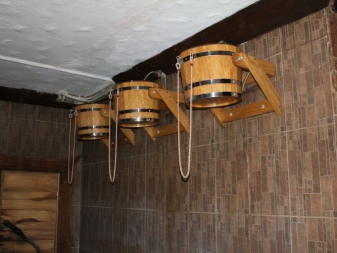

It is also necessary to select the correct fasteners, because the total weight of the water tank is about 60 kg.
Water supply
If the bath is equipped with running water, then it will not be at all difficult to bring water to the bucket. The water pipe should be raised to the level of the bucket attachment, the tap itself for supplying water to the tank is mounted at an average height of 1.5 m from the floor. A flexible hose is led into the bucket from the tap. After the water supply is finished, the bucket is mounted, the hose from the tap is connected to the float so that it regulates the flow of water.
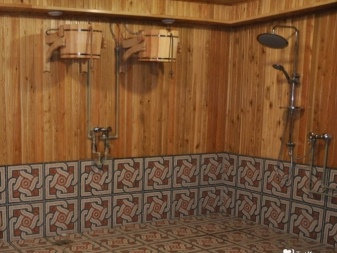
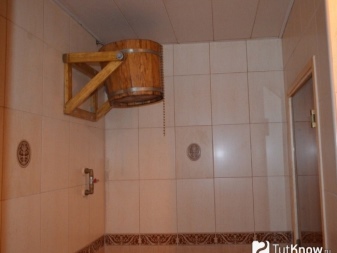
Description of dousing devices for a bath and their installation in the video below.




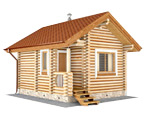
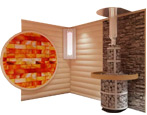
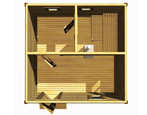
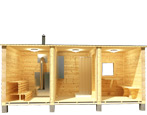
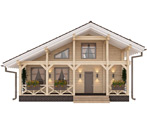



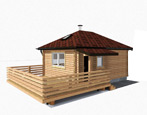
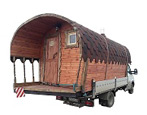


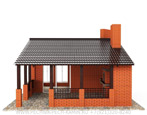

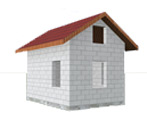

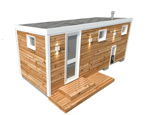
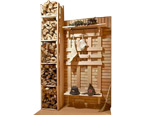
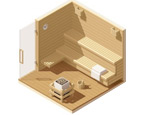
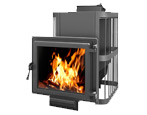
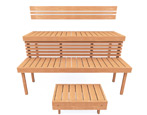
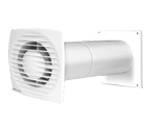




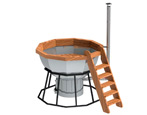

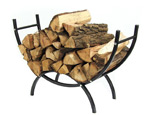
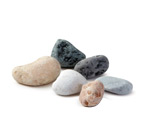
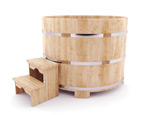
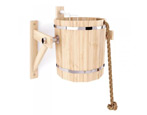
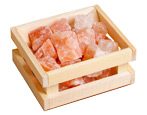

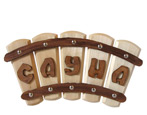
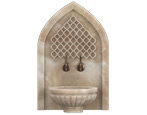
























































The comment was sent successfully.